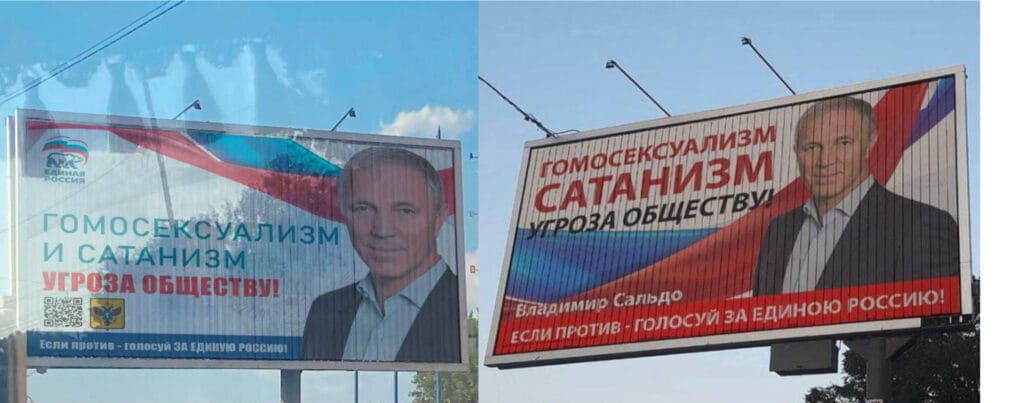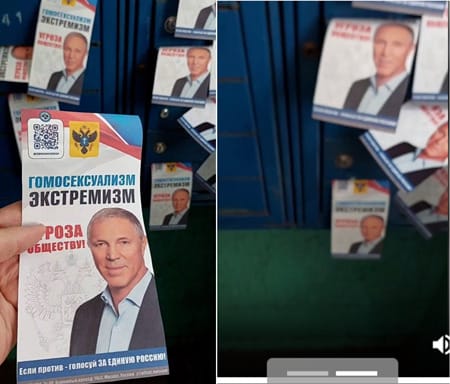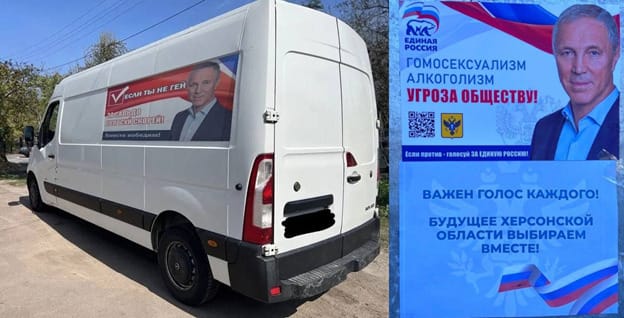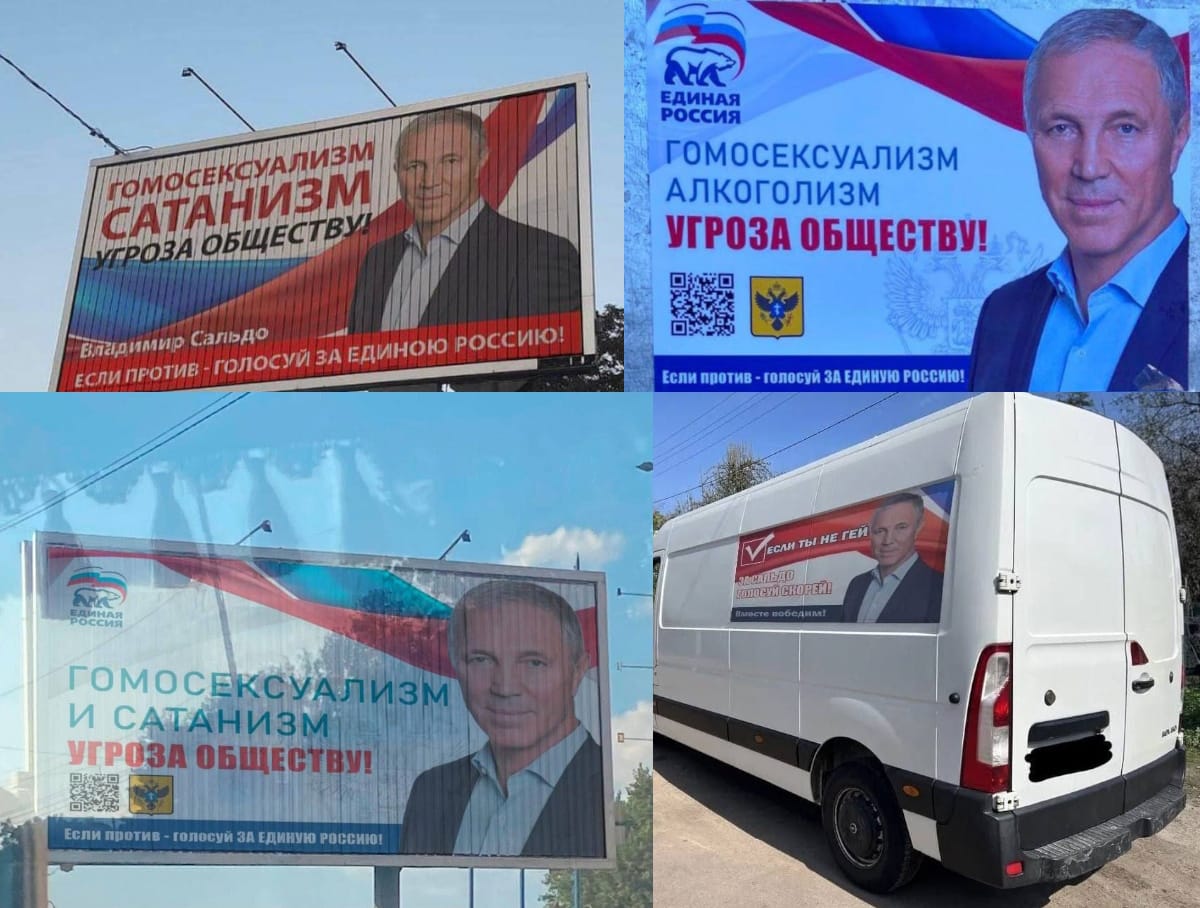In August 2023, social networks circulated photographs allegedly taken in the Russian-occupied part of the Kherson region on the eve of local elections. We have checked whether these pictures are genuine.
According to media and Telegram channels, the photographs were taken in the cities of Genichesk and Novaya Kakhovka in the Kherson region of Ukraine, which have been under the control of the Russian army since February 2022. Judging by the photographs, the candidate for the regional Duma from the United Russia party, the head of the Russian administration of the Kherson region, Vladimir Saldo, made the fight against LGBT people and Satanists a key theme of his election campaign. On billboards, cars and flyers you can see slogans such as “If you are not gay, vote for Saldo quickly” and “Homosexuality and Satanism are a threat to society!” Some posts were even accompanied by videos.
Such resources as “Saldo” wrote about such election slogans as “Echo", "Notebook", "Kherson Daily", SVTV, "Guys+" And Meta. The news caused a wide resonance in “VKontakte" and especially on Telegram, where it was shared, in particular, by the channels "Live broadcast"(757,000 views at the time of writing), VPS (360,000), "Media Russia is not Moscow» (277,000), Times of Ukraine (248,000), "Outsider"(186,000), "Yoshkin mole» (108,000) and Astra (51,000).
In September 2023, in the Russian-controlled part of the Kherson region of Ukraine, annexed following a referendum last fall, there should be held elections to the regional Duma. At the beginning of August, United Russia presented its list of candidates, which was headed by the acting governor of the region Vladimir Saldo. It was he who became the main character of the viral photos. Among them are pictures:
- two billboards with the slogan “Homosexuality and Satanism are a threat to society. If you are against it, vote for United Russia!”;

- flyers with the same slogan in mailboxes (these propaganda materials were also included in a five-second video);

- posters pasted on the car and in an unspecified place.

August 26, Russian-controlled regional election commission distributed advertising space and airtime for election campaigning of candidates. At the same time, the first messages about the allegedly already posted strange advertisement (with one of the billboards) appeared on the Internet at least on August 23. After the uproar, the regional election commission statedthat they did not register such materials.
According to Russian federal law, all printed and audiovisual campaign materials must, in particular, contain the name of the organization that produced them, its legal address and taxpayer identification number, the name of the organization that ordered the campaign, as well as information about the circulation and date of production. This data is not available on materials with photos and videos. But on three media you can see the QR code. On two of them (a poster and a billboard) the code is the same and, when scanned, leads to the Telegram channel of the Kherson Election Commission. But on the flyer it is completely different and does not lead anywhere.

At the same time, it would be logical if the same QR code was either present on all campaign materials or absent altogether.
Also on the flyer you can see the address of the printing house "Offset Moscow", located in the Russian capital. This in itself is not unusual, but if such a flyer was not registered in the Kherson Regional Election Commission, it means that even if printed in Moscow, it will be invalid.
The license plate on one of the photographs is blurred out. All other images have virtually no background, which makes geolocation difficult. There is a spelling mistake on one of the billboards: “United Russia.”

The portrait of Saldo used on all advertising media is presumably taken from Telegram channel policy. The photo itself is old - a fragment of it met on billboards in support of the politician even before the Russian invasion.
On pages on social networks associated with United Russia or personally with Vladimir Saldo, photographs with slogans about homosexuality and Satanism are not found. On real Propaganda billboards for “United Russia” in the occupied region do not use a photo of the Kremlin-appointed leader, the emphasis is on the entire party.
Pictures of supposedly propaganda materials in the occupied part of the Kherson region appeared gradually and in different sources. August 23 start spread photo of the first billboard, August 24 — poster with campaigning for Saldo, as well as a poster with the caption “Together with the LDPR against homosexuality” for candidate from this game by Arthur Vdovin. The authenticity of the second poster is also not confirmed, and the QR code on it does not lead to election resources, but to the personal Telegram channel of LDPR chairman Leonid Slutsky. On August 26, another one appeared on the Internet billboard, August 29 – images car with poster and flyers (as well as the corresponding video). Finally, on August 30th he began spread a new poster with Vladimir Saldo - it featured the slogan “The only candidate who is still alive.” This happened after a similar humorous comment on the topic of one of the billboards shared in his Telegram channel, Advisor to the Head of the Ministry of Internal Affairs of Ukraine Anton Gerashchenko (145,000 views). Apparently, this comment was the reason for creating and printing a new poster. Over and over again, only new samples of printed materials appeared on the Internet, but not once did a photograph of a previously published advertisement, taken from a different angle, appear on the Internet.
Thus, all the facts indicate that the posters, billboards and leaflets of United Russia with homophobic and anti-Satanist slogans in the occupied part of the Kherson region are fake. Billboard shots were likely created in a graphics editor, while flyers and posters were printed and subsequently photographed or filmed. How to websites, and in Telegram-channels, the earliest cases we discovered of publications mentioning each fake propaganda material were made by Ukrainian or pro-Ukrainian resources.
Cover photo: social networks
Read on topic:
- Is it true that a German TV channel showed on air a map of Ukraine changed as a result of the referendums?
- Did the Vice Speaker of the Polish Senate say that “Ukrainians are dying for the right to be homosexuals”?
- Did Oleg Gazmanov write on Twitter that he had to cancel a concert in Kherson due to unsold tickets?
If you find a spelling or grammatical error, please let us know by highlighting the error text and clicking Ctrl+Enter.






